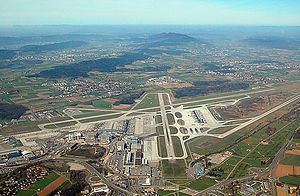Airport

An airport is a civil, private or military facility for aircraft to take off, land, and often be stored and maintained, minimally comprising a runway or other take-off and landing space, but often much larger and including aircraft hangars, air traffic control towers and terminal buildings.
Civil airports often provide access to towns, cities and remote areas, and provide services such as restaurants and lounges while passengers await their flights. The world's busiest airport is Atlanta International, followed by Beijing International and London Heathrow.
Airports usually consist of a long, flat landing and take-off strip, an accessible-from-the-air open space long enough for an plane to take off and to land[1], and which may have lights along it for nighttime landings. Airports maybe also include a helipad[2] for helicopters. Adjacent utility buildings may include air traffic control towers, aircraft hangars[3] and terminals where people can wait. Larger airports may have airport aprons, taxiway bridges, air traffic control centres, passenger facilities such as restaurants and lounges, and emergency services. In some countries, the US in particular, airports also typically have one or more fixed-base operators, serving general aviation.
Airport operations are extremely complex, with a complicated system of aircraft support services, passenger services, and aircraft control services contained within the operation. Thus airports can be major employers, as well as important hubs for tourism and other kinds of transit. Because they are sites of operation for heavy machinery, a number of regulations and safety measures have been implemented in airports, in order to reduce hazards. Additionally, airports have major local environmental impacts, as both large sources of air pollution, noise pollution and other environmental impacts, making them sites that acutely experience the environmental effects of aviation. Airports are also vulnerable infrastructure to extreme weather, climate change caused sea level rise and other disasters. It is often challenging for airports to be self-sufficient financially, so many municipalities struggle to find ways to keep them financially viable, given their importance to the local economy.
Attribution
- Some content on this page may previously have appeared on Wikipedia.
Footnotes